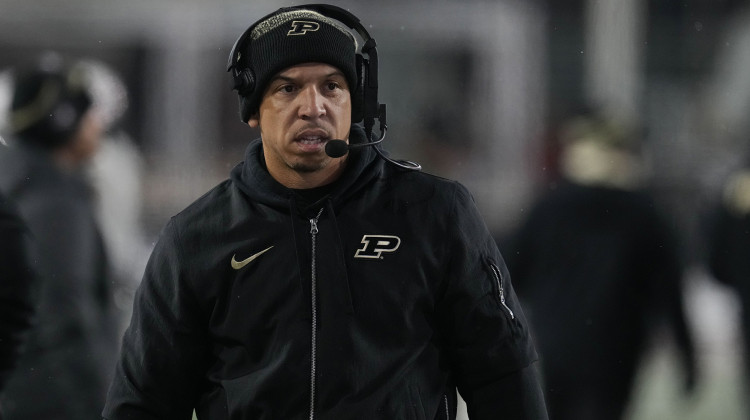GREENWOOD, Ind. (AP) — The carefully planted and planned restored prairie at Old City Park in Greenwood buzzed and hummed with activity.
Bees, flies and butterflies moved from flower to flower, sucking up nutrients. Stalks of goldenrod, prairie clover, swamp milkweed and purple coneflowers provided a buffet of sorts for all kinds of insects. Grasses rustled and waved in the breeze.
The prairie had been cultivated in a specific way, with more than 70 carefully chosen flowering perennials, grasses and trees native to Indiana.
Not only did the plants look attractive to people walking past, but each had a specific role in supporting the ecosystem, from insects to birds to small animals.
“Native plants are especially important because they have evolved to be in our area, as opposed to non-native plants or invasive plants. They have a relationship with our pollinators and our moths and butterflies,” said Blair Beavers, assistant director and education coordinator for the Johnson County Soil and Water Conservation District. “They’re the baseline of our entire ecosystem.”
That message is making its way to Johnson County homeowners, who are increasingly asking about native Indiana plants to landscape their yards. The plants offer a wealth of advantages — attractive for local wildlife, pleasant to look at and able to withstand the hot, dry summers and thrive.
To help people better understand the benefits, Purdue Extension Johnson County has planned a day-long program talking about these flowers, grasses and shrubs, as well as tours of area examples of landscaping using them. The hope is to help even more people grow the native plant movement.
“People want to attract pollinators, they want to attract wildlife. People want to get rid of the invasive plants and return to the native plants,” said Sarah Hanson, director for Purdue Extension Johnson County. “I’ve seen so much interest in that lately.”
In recent years, research into native plants has underscored the importance of using them in gardens and yards. Declining wildlife and plant populations threaten ecosystems that have thrived for centuries. Cultivating these kinds of plants provides food, shelter and other advantages to the natural world.
Native plant communities support much greater biodiversity than introduced or non-native plants, and biodiversity is vital for a stable ecosystem, according to the Indiana Native Plant Society. A 2018 study published in the journal Biological Invasions found that there were 68% fewer caterpillar species and 91% fewer caterpillars in study areas with non-native plants compared to native hedgerows.
“When you insects that only eat certain kinds of things, they can’s survive unless they have the right plants. If invasive plants crowd those good native plants out, it makes it even harder for the insects,” Hanson said. “Then it’s a chain — the birds that eat those insects or eat native plants struggle, animals that eat those insects don’t have enough food.”
Native plants helps build habitats for countless species, and landscaping that includes them allows stormwater to percolate safely into the soil rather than running superheated into rivers and streams.
Because native plants are already suited for Indiana’s unique landscape and climate, they require less watering and no fertilizer, making gardening easier.
“Indigenous plants are a significant part of a region’s geographic context — in fact, they help define it. They have proven themselves capable of surviving in a landscape for millennia,” said Michael Homoya, state botanist with the Indiana Department of Natural Resources.
As word has spread about the advantages of native plant landscaping, more and more people have approached Purdue Extension Johnson County asking questions about getting started, Hanson said.
The interest inspired extension organizers to create the native plant backyard landscaping program and tour.
Part of the tour will include the county extension office’s own rain garden, stocked entirely with plants native to Indiana. The rain garden was created about about three years ago as part of the office’s rainscaping program. Through the extension office has maintained the garden, it had not been part of any specific programs, Hanson said.
“We thought it would be nice to show it to people and help them understand how rain gardens and native plants can benefit the environment,” she said.
Participants in the native plant program will learn about that garden, and take a tour of rain gardens and native plantings that have been a focus of Greenwood Parks and Recreation and Greenwood Public Library. Gardens stocked with native plants outside the library, and at City Center Park, offer perfect examples of landscaping using plants perfectly suited for Indiana.
“It’s impressive the the City of Greenwood has put in the money and the people to focus on native plants, not just do the boring old landscaping. They understand the importance of native plants,” Hanson said.
Bookending the tours will be presentations by local native plant experts. Beavers will focus on starting native plants by seed.
“Native plants work a little bit differently from your vegetables, so you have to plant them in a different way,” she said.
In the afternoon, the group is scheduled to travel to Franklin College for a tour of its native landscaping and gardens, led by Alice Heikens, a professor of biology at the college who specializes in endangered species and plant communities, with research focusing on natural areas management with an emphasis on invasive species.
“Franklin College has made an effort to adapt their landscaping to get rid of invasives, so we wanted to see what they’ve done,” Hanson said.
The program will be held from 10 a.m. to 3 p.m. Oct. 20, starting in Greenwood and ending in Franklin. The cost is $20, and only 20 spots are available. Interested participants need to RSVP by Oct. 7.
IF YOU GO:
Native plants and backyard landscaping program
What: A program and tour teaching people how to get rid of invasive plants and add native plants to their landscape. The event will feature guest speakers and tours of local rain gardens and other native plant habitats.
When: 10 a.m. to 3 p.m. Oct. 20
Who: Purdue Extension Johnson County
Cost: $20
RSVP: By Oct. 7
How to register: A link to register can be found at facebook.com/PurdueextensionJohnsonCountyIndiana. For more information, contact Sarah Hanson at sspeedy@purdue.edu or at 317-736-3724.
 DONATE
DONATE







 Support WFYI. We can't do it without you.
Support WFYI. We can't do it without you.